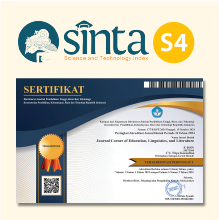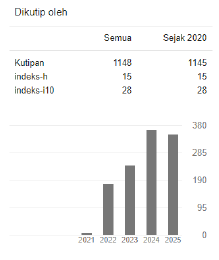The Effectiveness of Frontloading Strategies to Improve Students’ Reading Comprehension based on Gender
 https://doi.org/10.54012/jcell.v2i4.143
https://doi.org/10.54012/jcell.v2i4.143
 Abstract views: 727
Abstract views: 727
 PDF downloads: 369
PDF downloads: 369
Keywords:
Reading Comprehension, Frontloading Strategy, Narrative Text, GenderAbstract
This research belongs to quantitative research and aims to find the effectiveness of the frontloading strategy to improve students’ reading comprehension based on gender. The instrument given to the students was reading comprehension in the context of a narrative text. The research subject consisted of 25 students. This research only used experimental class for this research. As a result of this research, there was a significant improvement between pre-test and post-test scores. The result obtained from the sample T-test was found that the p-value (0,000) was lower than 0.05, and the t-observed (4,337) was higher than the t-table (2.059). While the result of differences in scores between females and a male based on post-test, the p-value (.240) was higher than 0.05, there were no significant differences in reading comprehension scores between females and males. So, this strategy makes students interested in teaching and learning reading comprehension. This technique also helps students to understand about material easily.
Downloads
References
Alam Samsul (2009).Using directed reading activity to teach reading comprehension to the second year students of MA aliyah syekh Yusuf. Thesis UIN Alauddin Makassar
Andrew P. Johnson. (2008). Teaching Reading and Writing, USA: Rowman & Littlefield Publishing Group,.
Elizabeth Pang,S, Muaka Angaluki Benbard B. Elizabeth, Kamil,L. Machel. (2003). Teaching Reading. ( Chicago Internal Academy Of Educational Series-12,)
Harmer, Jeremy. (2007). How to Teach English. (Pearson Education Limited ,).
Husna, Nurul., Jufri, Fitrawati. (2012). The Effect Of Using KWL Technique Toward Students’ Reading Comprehension: An Experimental Research In Teaching Hortatory Exposition Text At SMAN 1 Batipuh.Journal of English Language Teaching, ISSN: 2302-3198. 58-64. Retrieved from http://ejournal.unp.ac.id/index.php/jelt/article/view/356
Jahangard, Ali, Et.al. (2011). The Effect of Grammar vs. Vocabulary Pre-teaching on EFL Learners’ Reading Comprehension: A Schema- Theoretic View of Reading. Journal of English Language Teaching and Learning. No,8 92113
James, W. Brown, et al. (1959). A –V Instruction Materials and Methods, (New York: McGraw-Hill Book Company,), inc.
Jan McCall. (2005). Frontloading for ELL Learners: Building concepts and Vocabulary before Reading, Spotlight on Comprehension,
Jannete K Klingener, (2007). Vaughn Sharon And Boardman Alison Teaching Readingcomprehension To Students With Leraning Difficulties, New York. The GuildfordPress.
Joanne Schudt Caldwell. (2008). Comprehension Assessment A Classroom Guide. ( New York: The Guildford Press.).
June, P. (2006). Strategies to Build Students Vocabulary. Rapid City: TIE with support from SD Dept. of Education.
Kustaryo, S. (1998). Reading techniques for college students. Jakarta : LPTK
Mandy L. Downs. (2017). Effect of Front-loading Vocabulary for English as a Second Language Learners, (Minnesota: Saint Catherine University,).
Preszler. J. Et. Al. (2006). On Target : Strategies to Build Student Vocabularies.Rapid City : Black Hills Special Services Cooperative.
Robert J. Marzano. (2004). Building Background Knowledge for Academic Achievement, Research on What in School, (Alexandria: ASCD,).
Wilhelm, J. (2007). Frontloading: Preparing Students for Success Before Reading, Writing and Learning. New york : Boise State University
William Grabe. (2004). Handbook On Research On Teaching Reading,(M Cambridge; Cambridge University Press.
Downloads
Published
How to Cite
Issue
Section
License
Copyright (c) 2023 Ahmad Ad Dairaby

This work is licensed under a Creative Commons Attribution-ShareAlike 4.0 International License.
All articles published in the Journal Corner of Education, Linguistics, and Literature are licensed under the Creative Commons Attribution-ShareAlike License (CC BY-SA).

















